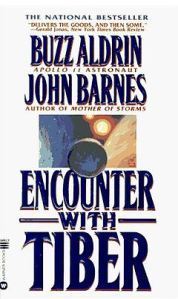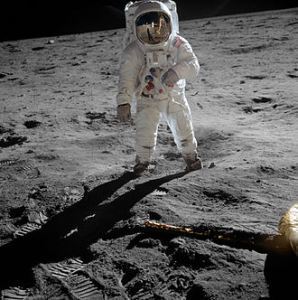Encounter with Tiber – hard sci-fi novel review
 Encounter with Tiber, by Buzz Aldrin and John Barnes, is a hard science fiction story for fans of space travel and colonization of the Moon and Mars. The long book (570 pages plus a foreword by Arthur C. Clarke and biographies of the authors) contains two related stories framed within a future historian’s voyage to Tiber.
Encounter with Tiber, by Buzz Aldrin and John Barnes, is a hard science fiction story for fans of space travel and colonization of the Moon and Mars. The long book (570 pages plus a foreword by Arthur C. Clarke and biographies of the authors) contains two related stories framed within a future historian’s voyage to Tiber.
One story starts with an alternative history of the end of the shuttle program and continues into the very near future with explorations of the Moon and Mars. This story is thick with detailed descriptions of technology and includes concepts familiar to fans of Aldrin’s writing, like the Mars to Earth cycler spacecraft. Indeed, long stretches of this story seems to lay a plot on top of his non-fiction book, Mission to Mars.
Here are a couple examples of the level of detail: “He disconnected the tube that supplied him with breathing oxygen from the place where it entered his suit on his left thigh” and “Clancy clamps, toothed clamps on a piece of pipe that tightened their grip when a small disk on the pipe was spun to the right.” This level of detail is not needed to advance the plot or understand the characters; it gives a realistic feel for being an astronaut in space.
The second story tells of humanoids (very human in nature) who came to Earth in the past, seeking a new home for their doomed race. This story is similarly full of scientific details, for example: “The closer a body comes to a large mass, like the Sun, the stronger the tidal effects – and the more difference in tidal effect there is from one side of the body to the other.” While this story contains more speculative technology, it has a similar realistic feel.

Buzz Aldrin on the Moon, Apollo 11, by NASA Headquarters of the United States under Photo ID: AS11-40-5903.
The book also deals with the politics of space. A recurring theme in both stories is political pressure leads to poor decisions and tragedy. Since Aldrin has been part of NASA’s space program for so long (yes, he is that Buzz Aldrin, the second man to walk on the Moon), it makes me wonder about the real-life events led to this pervasive element.
Even in moments of strong plot action, the authors will divert into technical details, which can make the book slow to read. It requires more concentration than a typical fun summer vacation book, and several times when I was tempted to start skimming, I put it down for a while.
If you are not a hard science fiction/space fiction fan, you may find this book tedious. If you love the details a space insider can provide, you’ll be fascinated.











